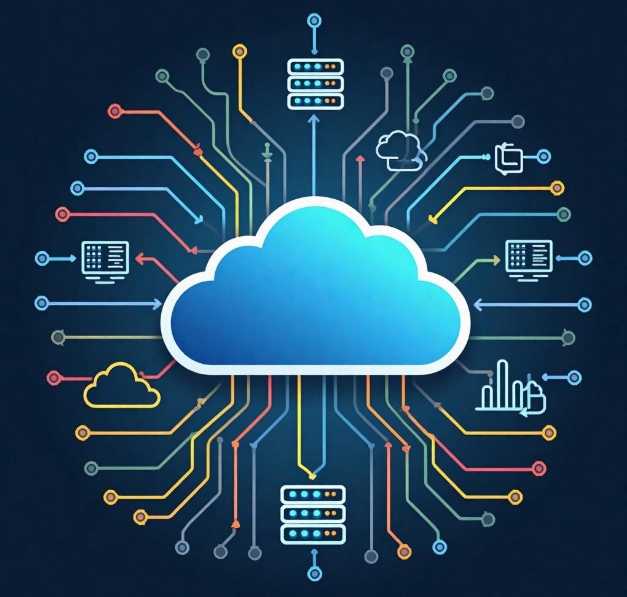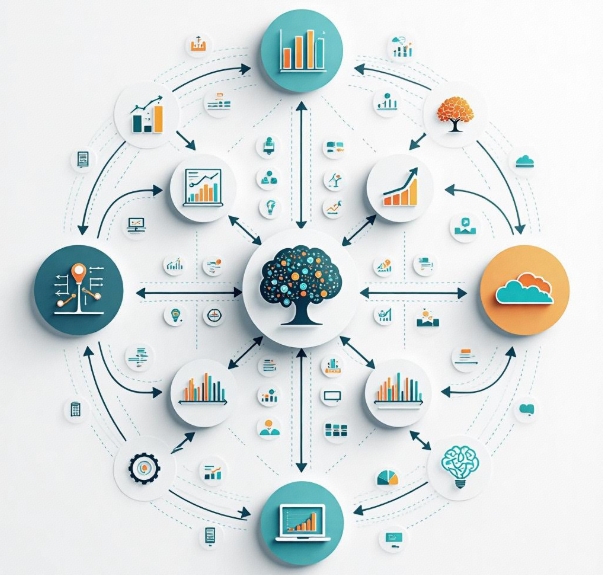Integration of Cloud Computing Applications and Big Data: Enhancing Decision-Making Efficiency
- latest articles
- 1.DApp Development & Customization: Merging Diverse Market Needs with User Experience 2.Analysis of the Core Technical System in DApp Project Development 3.How to achieve cross-chain interoperability in Web3 projects? 4.How does the tokenization of points reconstruct the e-commerce ecosystem? 5.How to Set and Track Data Metrics for a Points Mall? 6.What is DApp Development? Core Concepts and Technical Analysis 7.Inventory of commonly used Web3 development tools and usage tips 8.Development of a Distribution System Integrated with Social E-commerce 9.Six Key Steps for Businesses to Build a Points Mall System 10.What is DApp Development? A Comprehensive Guide from Concept to Implementation
- Popular Articles
- 1.Future Trends and Technology Predictions for APP Development in 2025 2.Analysis of the DeFi Ecosystem: How Developers Can Participate in Decentralized Finance Innovation 3.From Zero to One: How PI Mall Revolutionizes the Traditional E-commerce Model 4.DAPP Development | Best Practices for Professional Customization and Rapid Launch 5.Recommended by the Web3 developer community: the most noteworthy forums and resources 6.From Cloud Computing to Computing Power Leasing: Building a Flexible and Scalable Computing Resource Platform 7.How to Develop a Successful Douyin Mini Program: Technical Architecture and Best Practices 8.Shared Bike System APP: The Convenient Choice in the Era of Smart Travel 9.How to Create a Successful Dating App: From Needs Analysis to User Experience Design 10.From Design to Development: The Complete Process of Bringing an APP Idea to Life
With the rapid development of information technology, cloud computing and big data have become indispensable core technologies in modern enterprise management and decision-making. Cloud computing provides enterprises with flexible computing and storage capabilities, while big data offers more precise information for decision-making through its massive data integration and analysis. The combination of the two significantly enhances the efficiency and quality of corporate decision-making, driving the digital transformation across various industries. This article will start with the basic concepts of cloud computing and big data, explore the role of their integration in improving decision-making efficiency, and finally analyze their application prospects in different industries.
I. Basic Concepts of Cloud Computing and Big Data
1.1 Cloud Computing
Cloud computing is a technology that provides users with computing resources (such as servers, storage, databases, software, etc.) over the network. Users can utilize these resources on-demand without purchasing or maintaining hardware infrastructure. The advantages of cloud computing lie in its elasticity and flexibility, allowing enterprises to dynamically adjust resources based on actual needs and pay for usage, thereby reducing costs.
Cloud computing services are typically divided into three main types:
Infrastructure as a Service (IaaS): Provides virtualized computing resources, such as computing power, storage, and network resources.
Platform as a Service (PaaS): Offers developers a development platform and related services to assist in developing, testing, and deploying applications.
Software as a Service (SaaS): Delivers software applications over the network, allowing users to use them on-demand without the need for installation and maintenance.
1.2 Big Data
Big data refers to massive, diverse, and rapidly growing datasets that cannot be processed or analyzed using traditional database tools. The characteristics of big data are often summarized as the "4Vs":
Volume: The enormous amount of data.
Variety: The diversity of data sources, including structured, semi-structured, and unstructured data.
Velocity: The extremely fast rate at which data is generated, requiring real-time processing.
Veracity: The quality and reliability of data, especially when dealing with massive datasets, where accuracy and trustworthiness are critical issues.
Big data technologies include data mining, machine learning, natural language processing, etc., which can extract potential valuable information from vast amounts of data, providing a scientific basis for decision-making.
II. The Integration of Cloud Computing and Big Data
2.1 Cloud Computing's Support for Big Data Processing
Cloud computing provides robust support for the storage, processing, and analysis of big data. The volume of big data is typically enormous, making it difficult for traditional hardware to handle such massive datasets. Cloud computing platforms, through virtualization technology, offer elastic computing and storage resources, enabling efficient storage and distributed processing of big data. For example, cloud platforms like Amazon Web Services (AWS) and Microsoft Azure provide numerous tools and services for big data analysis, such as Hadoop and Spark, helping enterprises perform large-scale data processing and analysis in the cloud.
Through cloud computing, enterprises can leverage the computing power of cloud platforms to process and analyze big data without investing heavily in hardware resources. Companies can quickly scale storage and computing capacity based on demand, lowering technical barriers and enhancing the flexibility of big data applications.
2.2 The Integration of Big Data Analysis and Cloud Computing: Accelerating Decision-Making
Traditional decision-making methods often rely on fixed reports and historical data, which are typically limited in scope and involve cumbersome analysis processes, often failing to respond quickly to market changes. The introduction of big data has changed this landscape by enabling real-time analysis of massive datasets, providing decision-makers with multi-dimensional information and making decisions more scientific and precise. The flexibility, scalability, and efficiency of cloud computing further accelerate this process.
In the context of integrating cloud computing and big data, enterprises can monitor and analyze multi-dimensional data such as market trends, consumer behavior, and production efficiency in real-time, thereby making more timely and accurate decisions. For example, through cloud platforms, companies can instantly access global market data, quickly identify potential market opportunities or risks, and adjust their strategies accordingly.
2.3 Specific Manifestations of Improved Decision-Making Efficiency
Real-Time Decision-Making: The elasticity of cloud computing and the real-time processing capabilities of big data enable enterprises to obtain the latest data analysis results at any time, allowing for prompt responses. For instance, in the e-commerce industry, the integration of cloud computing and big data can help platforms analyze consumer shopping behavior in real-time, providing data support for promotional activities and product recommendations.
Data-Driven Decision-Making: Traditional decision-making often relies on experience and intuition, whereas modern enterprises tend to rely more on data to guide decisions. Through big data analysis, companies can gain more comprehensive and in-depth market insights, reducing human bias and improving decision accuracy.
Automated Decision-Making: With the continuous development of machine learning and artificial intelligence, the integration of cloud computing and big data enables the automation of decision-making processes. For example, in the financial sector, by analyzing customer credit data with big data and leveraging the computing power of cloud platforms, banks can automate loan approval processes, enhancing efficiency and reducing human operational errors.
III. Applications of Cloud Computing and Big Data in Different Industries
3.1 Applications in the Financial Industry
In the financial industry, the integration of cloud computing and big data has brought revolutionary changes to areas such as risk control, customer analysis, and robo-advisors. Financial institutions can analyze vast amounts of market data, customer behavior data, and macroeconomic data to predict market trends, assess investment risks, and provide customized financial services. For example, by analyzing customer spending behavior with big data, banks can accurately assess the repayment capacity of credit card users and offer more personalized loan products.
Additionally, the elastic resources of cloud computing enable financial institutions to process and store data more efficiently, significantly improving the efficiency of risk management.
3.2 Applications in the Retail Industry
The integration of cloud computing and big data in the retail industry has facilitated personalized marketing and precise inventory management. By analyzing data on consumer purchasing behavior, browsing history, and social media interactions, retailers can better understand consumer preferences and needs, thereby developing personalized marketing strategies.
At the same time, the storage and computing capabilities of cloud platforms help retailers achieve precise inventory management. Through big data analysis, retailers can predict sales trends for different products, avoiding overstocking or stockouts, thereby enhancing supply chain efficiency.
3.3 Applications in the Healthcare Industry
The digital transformation of the healthcare industry relies on the support of cloud computing and big data. Through cloud computing, medical institutions can store and share vast amounts of medical data, while big data analysis can extract important medical information from patients' historical records, genetic data, and clinical trial data, providing decision support for doctors.
For example, based on big data analysis, medical institutions can comprehensively analyze patients' medical histories on cloud platforms, providing data support for precision treatment and personalized medicine. This not only improves the efficiency of medical services but also reduces healthcare costs to some extent.
IV. Future Outlook
With the continuous development of technology, the integration of cloud computing and big data will play an increasingly important role across various industries. In the future, with the ongoing advancement of technologies such as artificial intelligence and edge computing, the combination of cloud computing and big data will become even tighter, driving corporate decision-making towards greater intelligence and automation.
Specifically, cloud computing and big data will enable enterprises to more accurately predict market changes, optimize resource allocation, and enhance customer experiences, thereby standing out in the fierce market competition. At the same time, with continuous improvements in data privacy protection and security technologies, enterprises can better address challenges related to data security and privacy while enjoying the benefits brought by big data and cloud computing.
Conclusion
In summary, the integration of cloud computing and big data provides enterprises with a powerful technological platform, helping to improve decision-making efficiency and driving digital transformation across various industries. In the future, with the continuous development of technology and the expansion of application scenarios, cloud computing and big data will offer decision-makers more intelligent and precise decision support, injecting continuous momentum into enterprise innovation and development.
-

Applications and Challenges of Cloud Computing in the Internet of Things (IoT)
With the continuous advancement of information technology, cloud computing and t···
-

Integration of Cloud Computing and Artificial Intelligence: Enhancing Intelligent Applications
With the rapid advancement of technology, cloud computing and artificial intelli···
-

Data Security and Privacy Protection in Cloud Computing Applications
With the continuous advancement of information technology and the rapid developm···

 Blockchain
Blockchain












